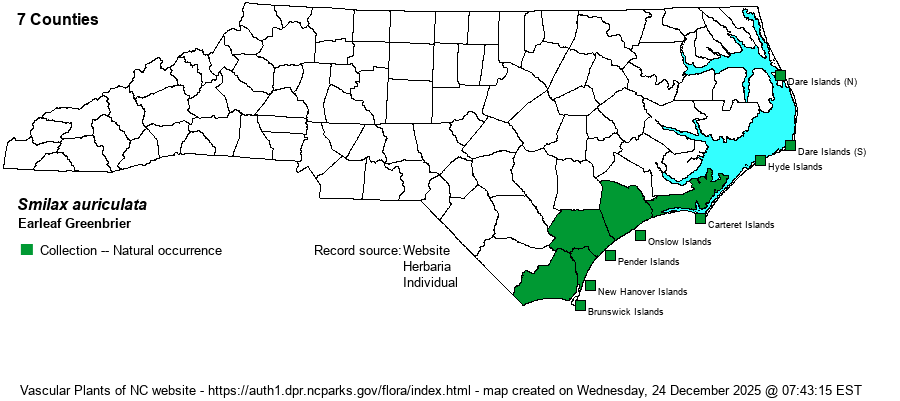| Author | Walter | |
| Distribution | Strictly along the coast, within a mile of the ocean, ranging north to Dare County.
This is a Southern species, ranging north to coastal NC, south to southern FL, and west to eastern LA. It also occurs in the Bahamas.
| |
| Abundance | Common to very common within its restricted habitat on coastal dunes. This can be the most frequently seen woody species on some stretches of dunes along our coast. | |
| Habitat | This species is almost solely restricted to dunes and sandy thickets very close to the ocean, such as the margins of maritime forests and maritime shrub thickets. |
| Phenology | Blooms from May to July, and fruits from October to November, persisting into the winter. | |
| Identification | This is an evergreen woody vine that forms dense stands over bushes and saplings, but it is not a high-climbing vine seen growing up into trees. It is normally seen as a dense “ball” growing on the back side of dunes. The leaves are fiddle-shaped, with small side lobes near the base; the leaves are entire and are not spiny edged, and they often grow to about 3 inches long. There are few to no spines along the stem. In fall and early winter, the many clusters of small blackish berries are conspicuous. The leaves of Saw Greenbrier (S. bona-nox) are quite similar, but they are armed along the margins with numerous spines; the leaves also tend to be variegated with patches of pale green, and the basal lobes tend to be larger. Smilax auriculata normally has green leaves with no blotches of lighter green on the dorsal surface. | |
| Taxonomic Comments | None
| |
| Other Common Name(s) | Dune Greenbrier, Wild-bamboo | |
| State Rank | S3 | |
| Global Rank | G4? | |
| State Status | | |
| US Status | | |
| USACE-agcp | FACU link |
| USACE-emp | FACU link |

